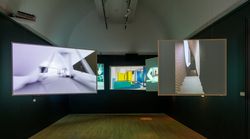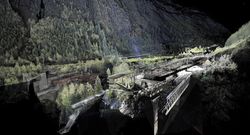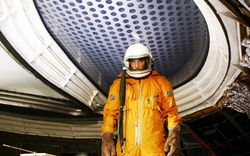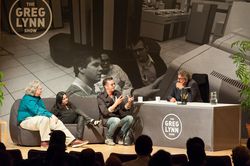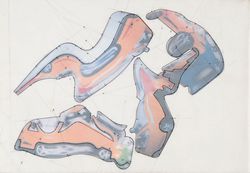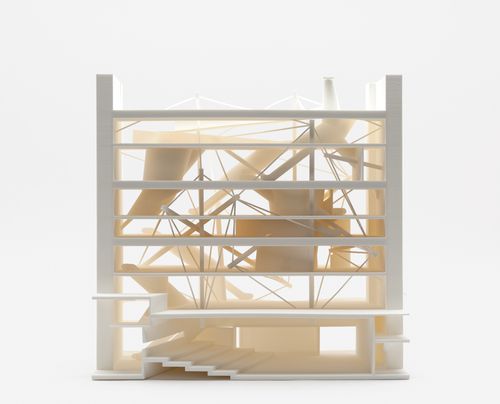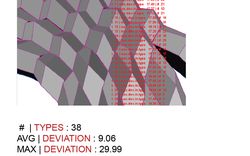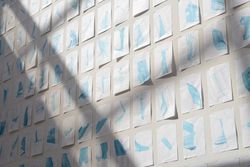Archéologie du numérique : complexité et convention représente le troisième et dernier volet d’une série d’expositions liées à la constitution d’archives numériques au CCA. Le programme Archéologie du numérique comprend vingt-cinq projets pour lesquels les documents numériques constituent des éléments essentiels à la compréhension du processus de conception(...)
11 mai 2016 au 16 octobre 2016
Archéologie du numérique : complexité et convention
Actions:
Description:
Archéologie du numérique : complexité et convention représente le troisième et dernier volet d’une série d’expositions liées à la constitution d’archives numériques au CCA. Le programme Archéologie du numérique comprend vingt-cinq projets pour lesquels les documents numériques constituent des éléments essentiels à la compréhension du processus de conception(...)
Dénouer le paysage numérique
Dans cette conférence, Christophe Girot aborde les modèles de paysage numérique : Le design et l’analyse du paysage numérique ont traversé une révolution tranquille au cours des dix dernières années, suscitée par l’introduction de modèles numériques de nuages de points. La portée et la précision de ces modèles de paysages numériques créés à l’aide de lecteurs laser(...)
Théâtre Paul-Desmarais
6 octobre 2016, 18h
Dénouer le paysage numérique
Actions:
Description:
Dans cette conférence, Christophe Girot aborde les modèles de paysage numérique : Le design et l’analyse du paysage numérique ont traversé une révolution tranquille au cours des dix dernières années, suscitée par l’introduction de modèles numériques de nuages de points. La portée et la précision de ces modèles de paysages numériques créés à l’aide de lecteurs laser(...)
Théâtre Paul-Desmarais
articles
Des origines du numérique
The Greg Lynn Show
Greg Lynn sur scène, en conversation avec les architectes de projets inclus dans l’exposition __Archéologie du numérique : Complexité et convention_. Les conversations constituent un des aspects importants du programme Archéologie du numérique du CCA. Greg Lynn a ainsi discuté avec les architectes de projets produits de la fin des années 1980 jusqu’aux années 2000, afin(...)
11 mai 2016
The Greg Lynn Show
Actions:
Description:
Greg Lynn sur scène, en conversation avec les architectes de projets inclus dans l’exposition __Archéologie du numérique : Complexité et convention_. Les conversations constituent un des aspects importants du programme Archéologie du numérique du CCA. Greg Lynn a ainsi discuté avec les architectes de projets produits de la fin des années 1980 jusqu’aux années 2000, afin(...)
Dans cette conférence, Amy Kulper situe le « virage numérique » de l’architecture en 1988, avec la création de Photoshop par Thomas Knoll. Développé à l’origine en tant que logiciel d’édition d’images, Photoshop s’inscrivait parfaitement dans la longue histoire de la correction optique dans la discipline architecturale. Pourtant, son omniprésence aujourd’hui soulève de(...)
Théâtre Paul-Desmarais
9 juin 2016, 18h
Amy Kulper : Le « virage numérique » et l’avènement de Photoshop
Actions:
Description:
Dans cette conférence, Amy Kulper situe le « virage numérique » de l’architecture en 1988, avec la création de Photoshop par Thomas Knoll. Développé à l’origine en tant que logiciel d’édition d’images, Photoshop s’inscrivait parfaitement dans la longue histoire de la correction optique dans la discipline architecturale. Pourtant, son omniprésence aujourd’hui soulève de(...)
Théâtre Paul-Desmarais
DR2017:0019
Description:
Model reproduced by CCA from STL files in the Preston Scott Cohen Eyebeam project records (AP190) for the exhibition Archaeology of the Digital: Complexity and Convention, 2016.
2016
3D printed model of Preston Scott Cohen Eyebeam competition entry
Actions:
DR2017:0019
Description:
Model reproduced by CCA from STL files in the Preston Scott Cohen Eyebeam project records (AP190) for the exhibition Archaeology of the Digital: Complexity and Convention, 2016.
articles
Des origines du numérique
Les outils numériques ont changé la nature profonde de la conception et de la réalisation des bâtiments, c’est une évidence. Pourtant, l’innovation et l’inventivité formelles (et les compétences techniques nécessaires pour parvenir à ces fins) ne dépendent pas uniquement de la virtuosité dans la création de formes. Elles font également ressortir l’incidence marquante des(...)
Théâtre Paul-Desmarais
20 octobre 2016, 18h
Conseils judicieux et dessins clairs : conception et calcul au deuxième âge de la machine
Actions:
Description:
Les outils numériques ont changé la nature profonde de la conception et de la réalisation des bâtiments, c’est une évidence. Pourtant, l’innovation et l’inventivité formelles (et les compétences techniques nécessaires pour parvenir à ces fins) ne dépendent pas uniquement de la virtuosité dans la création de formes. Elles font également ressortir l’incidence marquante des(...)
Théâtre Paul-Desmarais
Quand Gordon Matta-Clark se procure les titres de propriété et la documentation d’une douzaine de petites parcelles non occupées à New York entre 1974 et 1977 (qui, en 1992, ont fait l’objet d’une exposition intitulée Reality Properties: Fake Estates), il n’a pas d’intention précise – autre que sa conviction suivant laquelle « l’existence de lots vacants et sous-utilisés(...)
Théâtre Paul-Desmarais
22 septembre 2016, 18h
Nicholas de Monchaux : Local Code
Actions:
Description:
Quand Gordon Matta-Clark se procure les titres de propriété et la documentation d’une douzaine de petites parcelles non occupées à New York entre 1974 et 1977 (qui, en 1992, ont fait l’objet d’une exposition intitulée Reality Properties: Fake Estates), il n’a pas d’intention précise – autre que sa conviction suivant laquelle « l’existence de lots vacants et sous-utilisés(...)
Théâtre Paul-Desmarais
Série(s)
AP168.S1
Description:
The Project records from Neil Denari series, 1994 – 2004, consists of records produced by Denari for his show “Interrupted Projections” at Gallery MA in Tokyo, Japan. It documents the development and final design for the principal architectural installation built on the third level of the gallery, as well as related materials displayed on the gallery’s fourth floor. The series also contains photographic and video documentation of the exhibit, the show catalogue, and promotional materials. The series includes 4003 digital files (1 GB), 53 slides, 21 transparencies, seven drawings and/or reprographic copies, two VHS video cassettes, one exhibition catalogue, and a small amount of promotional material comprising one large and two small posters, one postcard, and one t-shirt. The majority of records date from 1994-1996. Denari used a combination of physical drawings and digital modelling to draft the design for Interrupted Projections. The series contains one ink drawing and one transfer print with plans and sections of the third floor gallery space, two reprographic copies of drawings with elevations and plans of existing conditions of the third and fourth floors at Gallery MA, and three graphite hand drawings of the installation. Digital files in the series include two original Softimage databases containing full and partial 3D models of the installation, as well as one forward-migrated database containing models compiled from the two original databases. The original models were created in Softimage ’95 on Windows NT and will not open in contemporary versions of Autodesk Softimage. The forward-migrated model database was created by members of Autodesk’s Montreal office for the Archaeology of the Digital exhibition Complexity and Convention and will open in Softimage 2014. Each Softimage model database is made up of several directories that contain information necessary to render all models and their animation into a “scene” (such as textures, lighting, camera movements, etc.). When the Interrupted Projections models were migrated, the information from all directories in both original databases was compiled into the Scenes directory of a single database. These updated scene files (SCN) contain all the elements needed to render the models without the need for additional directories. Each scene file has a corresponding scene TOC file (scene table of content), which can be used to further modify the information in the scene. Scene files in the migrated database contain full and partial models for Interrupted Projections, including one animated scene that follows a camera path through the interior and exterior of the final model. These files document the various stages of design work for the project, as well as Denari’s use of animation features in Softimage to visualize and study the spatial character of his drawings. Project collaborator Duks Koschitz created additional animations of the model that were edited and shown on the fourth floor of the exhibition. A compilation of his work is included on a VHS tape in the archive. The video, which spans one minute 16 seconds, contains four animations that move around the 3D gallery space. Koschitz attempted to reflect the concerns of the project in the movements of the camera, focusing on details such as the fictional company logos or curvatures in the surface of the model. The majority of photographic materials in the series are digital renderings of the model, comprising 38 slides, 14 diapositives, and seven digital images. Photographic materials also include images of the completed show, including seven diapositives that document the built work from various views on the third floor of Gallery MA, as well as the exhibition of materials on the fourth floor. A small number of slides document the exhibit open to the public, and include images of visitors interacting with the Sony Navicam. Most of the diapositive photographs and a small number of slides were taken by Fujitsuka Mitsumasa, a photographer of architecture based in Tokyo. A second VHS tape in the archive provides in-depth documentation of the Interrupted Projections exhibition, containing 45 minutes of raw video footage that explores Gallery MA and surrounding areas of Tokyo. The Interrupted Projections book contains in print the text and images from the installation and website. It was written by Denari and designed by Michiharu Shimoda, a graphic designer and underground trip-hop artist who was also responsible for the design of the fictional logos used in the exhibit. The book acts as an extension of the content of the show, as well as exhibition catalogue, and covers Denari’s other projects represented in the show. The series also contains a small amount of promotional media for Interrupted Projections, including one large and two small posters, a postcard, and a t-shirt.
1994 - 2004
Project records from Neil Denari
Actions:
AP168.S1
Description:
The Project records from Neil Denari series, 1994 – 2004, consists of records produced by Denari for his show “Interrupted Projections” at Gallery MA in Tokyo, Japan. It documents the development and final design for the principal architectural installation built on the third level of the gallery, as well as related materials displayed on the gallery’s fourth floor. The series also contains photographic and video documentation of the exhibit, the show catalogue, and promotional materials. The series includes 4003 digital files (1 GB), 53 slides, 21 transparencies, seven drawings and/or reprographic copies, two VHS video cassettes, one exhibition catalogue, and a small amount of promotional material comprising one large and two small posters, one postcard, and one t-shirt. The majority of records date from 1994-1996. Denari used a combination of physical drawings and digital modelling to draft the design for Interrupted Projections. The series contains one ink drawing and one transfer print with plans and sections of the third floor gallery space, two reprographic copies of drawings with elevations and plans of existing conditions of the third and fourth floors at Gallery MA, and three graphite hand drawings of the installation. Digital files in the series include two original Softimage databases containing full and partial 3D models of the installation, as well as one forward-migrated database containing models compiled from the two original databases. The original models were created in Softimage ’95 on Windows NT and will not open in contemporary versions of Autodesk Softimage. The forward-migrated model database was created by members of Autodesk’s Montreal office for the Archaeology of the Digital exhibition Complexity and Convention and will open in Softimage 2014. Each Softimage model database is made up of several directories that contain information necessary to render all models and their animation into a “scene” (such as textures, lighting, camera movements, etc.). When the Interrupted Projections models were migrated, the information from all directories in both original databases was compiled into the Scenes directory of a single database. These updated scene files (SCN) contain all the elements needed to render the models without the need for additional directories. Each scene file has a corresponding scene TOC file (scene table of content), which can be used to further modify the information in the scene. Scene files in the migrated database contain full and partial models for Interrupted Projections, including one animated scene that follows a camera path through the interior and exterior of the final model. These files document the various stages of design work for the project, as well as Denari’s use of animation features in Softimage to visualize and study the spatial character of his drawings. Project collaborator Duks Koschitz created additional animations of the model that were edited and shown on the fourth floor of the exhibition. A compilation of his work is included on a VHS tape in the archive. The video, which spans one minute 16 seconds, contains four animations that move around the 3D gallery space. Koschitz attempted to reflect the concerns of the project in the movements of the camera, focusing on details such as the fictional company logos or curvatures in the surface of the model. The majority of photographic materials in the series are digital renderings of the model, comprising 38 slides, 14 diapositives, and seven digital images. Photographic materials also include images of the completed show, including seven diapositives that document the built work from various views on the third floor of Gallery MA, as well as the exhibition of materials on the fourth floor. A small number of slides document the exhibit open to the public, and include images of visitors interacting with the Sony Navicam. Most of the diapositive photographs and a small number of slides were taken by Fujitsuka Mitsumasa, a photographer of architecture based in Tokyo. A second VHS tape in the archive provides in-depth documentation of the Interrupted Projections exhibition, containing 45 minutes of raw video footage that explores Gallery MA and surrounding areas of Tokyo. The Interrupted Projections book contains in print the text and images from the installation and website. It was written by Denari and designed by Michiharu Shimoda, a graphic designer and underground trip-hop artist who was also responsible for the design of the fictional logos used in the exhibit. The book acts as an extension of the content of the show, as well as exhibition catalogue, and covers Denari’s other projects represented in the show. The series also contains a small amount of promotional media for Interrupted Projections, including one large and two small posters, a postcard, and a t-shirt.
Series
1994 - 2004
